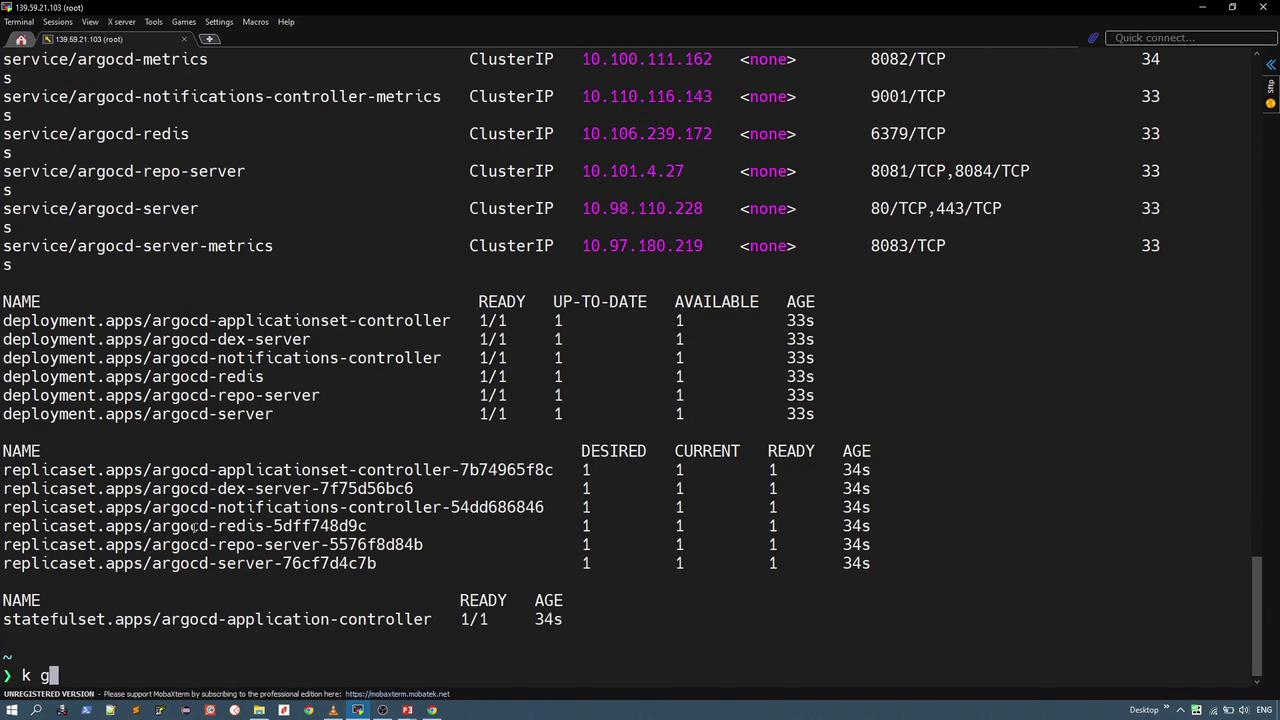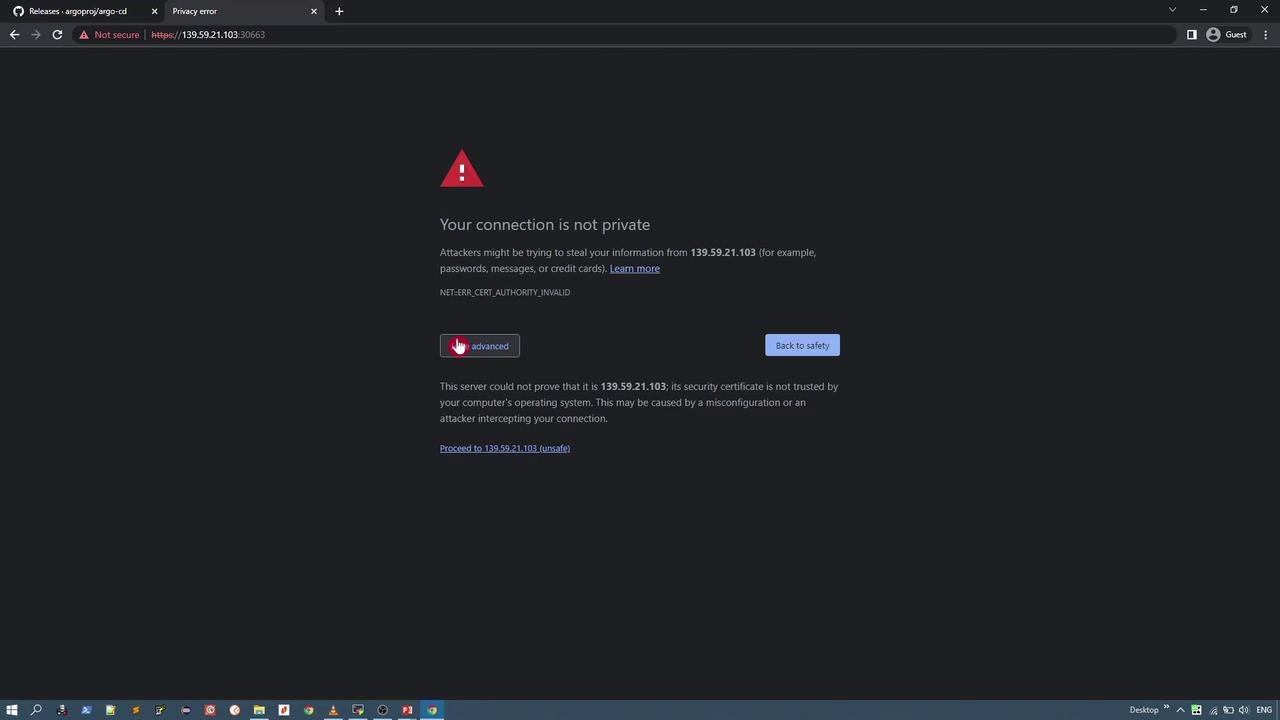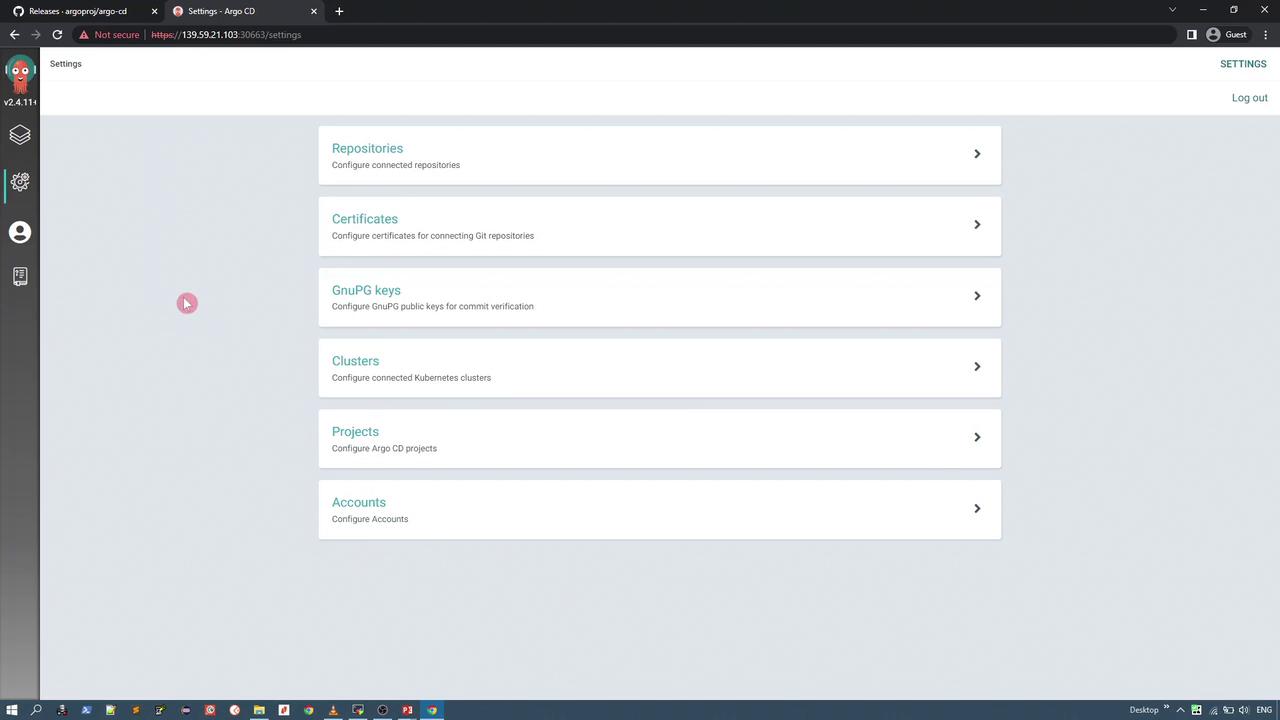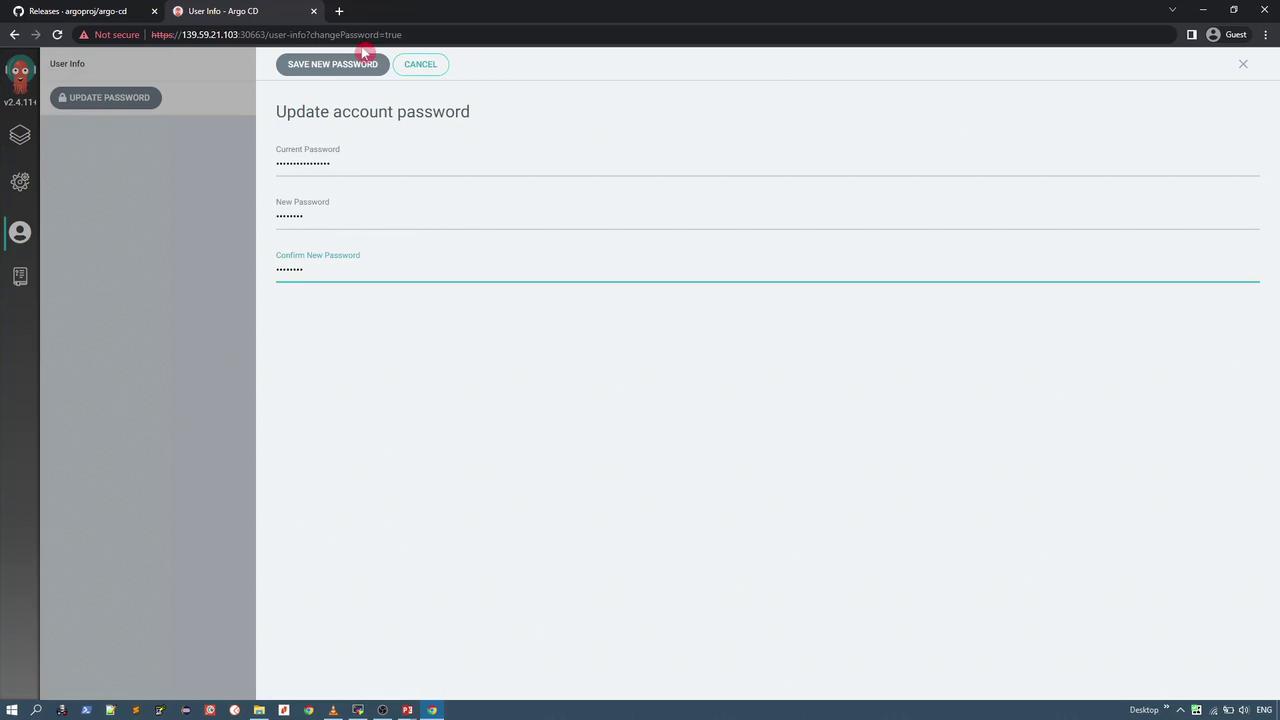GitOps with ArgoCD
ArgoCD Basics
ArgoCD Installation
In this lesson, we will guide you through installing ArgoCD and its CLI. We follow the official ArgoCD documentation from the Getting Started page to ensure you have the latest best practices. The installation process includes creating a dedicated Kubernetes namespace, applying the official manifest, and configuring the ArgoCD server for external access.
Installing ArgoCD
Start by creating the "argocd" namespace and applying the stable manifest:
kubectl create namespace argocd
kubectl apply -n argocd -f https://raw.githubusercontent.com/argoproj/argo-cd/stable/manifests
You can also install the ArgoCD CLI on your machine. For Homebrew users, execute:
brew install argocd
After installing the CLI, patch the ArgoCD server service to expose it externally as a LoadBalancer and then forward the port:
kubectl patch svc argocd-server -n argocd -p '{"spec": {"type": "LoadBalancer"}}'
kubectl port-forward svc/argocd-server -n argocd 8800:443
For this lesson, we are using version 2.4.11 of ArgoCD. If you need to install a specific version, run:
kubectl create namespace argocd
kubectl apply -n argocd -f https://raw.githubusercontent.com/argoproj/argo-cd/v2.4.12/manifests/install.yaml
There are two installation options available: non-HA and HA. For simplicity, this lesson utilizes the non-HA version. Copy and execute the following commands:
kubectl create namespace argocd
kubectl apply -n argocd -f https://raw.githubusercontent.com/argoproj/argo-cd/V2.4.11/manifests/install.yaml
This installation is performed on a single-node Kubernetes cluster running version 1.24.3. Verify your node status with:
kubectl get nodes
Expected output:
NAME STATUS ROLES AGE VERSION
demo-cluster Ready control-plane 18h v1.24.3
Verifying the Installation
After installation, check the resources created in the "argocd" namespace. The following command displays all deployments, pods, and services:
kubectl get all -n argocd
A sample output might be:
NAME READY UP-TO-DATE AVAILABLE AGE
deployment.apps/argocd-applicationset-controller 0/1 1 0 11s
deployment.apps/argocd-dex-server 0/1 1 0 11s
deployment.apps/argocd-notifications-controller 1/1 1 1 11s
deployment.apps/argocd-redis 0/1 1 0 11s
deployment.apps/argocd-repo-server 0/1 1 0 11s
deployment.apps/argocd-server 0/1 1 0 11s
NAME DESIRED CURRENT READY AGE
replicaset.apps/argocd-applicationset-controller-7b74965f8c 1 1 0 11s
replicaset.apps/argocd-dex-server-7f75d56bc6 1 1 0 11s
replicaset.apps/argocd-notifications-controller-54dd686846 1 1 1 11s
replicaset.apps/argocd-redis-5dff748d9c 1 1 0 11s
replicaset.apps/argocd-repo-server-5576f8d84b 1 1 0 11s
replicaset.apps/argocd-server-76cf74d4c7b 1 1 0 11s
NAME
statefulset.apps/argocd-application-controller 0/1 11s
After a few minutes, when all deployments are fully initialized, verify that all pods are running:
kubectl get all -n argocd
Example output once the pods are running:
NAME READY STATUS RESTARTS AGE
pod/argocd-application-controller-0 1/1 Running 0 33s
pod/argocd-applicationset-controller-7b74965f8c-7fnw4 1/1 Running 0 33s
pod/argocd-dex-server-77d56b6c6-nvj96 1/1 Running 0 33s
pod/argocd-notifications-controller-54d686846-4b4r4 1/1 Running 0 33s
pod/argocd-redis-5dff748d9c-psrw 1/1 Running 0 33s
pod/argocd-repo-server-5576f8d84b-whtsg 1/1 Running 0 33s
pod/argocd-server-76c7d4c7b-fnkdk 1/1 Running 0 33s
To check the status of services:
kubectl get svc -n argocd
Example output:
NAME TYPE CLUSTER-IP EXTERNAL-IP PORT(S) AGE
service/argocd-applicationset-controller ClusterIP 10.100.58.34 <none> 7000/TCP,8080/TCP 34s
service/argocd-dex-server ClusterIP 10.109.179.192 <none> 5556/TCP,5557/TCP,5558/TCP 34s
service/argocd-metrics ClusterIP 10.100.111.162 <none> 8082/TCP 34s
service/argocd-notifications-controller-metrics ClusterIP 10.110.116.143 <none> 9001/TCP 33s
service/argocd-redis ClusterIP 10.106.239.172 <none> 6379/TCP 33s
service/argocd-repo-server ClusterIP 10.101.4.27 <none> 8081/TCP,8084/TCP 33s
service/argocd-server ClusterIP 10.98.110.228 <none> 80/TCP,443/TCP 33s
service/argocd-server-metrics ClusterIP 10.97.180.219 <none> 8083/TCP 33s

Exposing the ArgoCD Server
By default, ArgoCD services are configured with the ClusterIP type, which restricts external access. To access the ArgoCD UI, modify the ArgoCD server service to use the NodePort type. Edit the service and change the "type" field:
creationTimestamp: "2022-09-23T14:01:00Z"
labels:
app.kubernetes.io/component: server
app.kubernetes.io/name: argocd-server
app.kubernetes.io/part-of: argocd
name: argocd-server
namespace: argocd
resourceVersion: "81300"
uid: 23c477a6-23ad-4c14-8874-2f144ba396e3
spec:
clusterIP: 10.98.110.228
clusterIPs:
- 10.98.110.228
internalTrafficPolicy: Cluster
ipFamiles:
- IPv4
ipFamilyPolicy: SingleStack
ports:
- name: http
port: 80
protocol: TCP
targetPort: 8080
- name: https
port: 443
protocol: TCP
targetPort: 8080
selector:
app.kubernetes.io/name: argocd-server
sessionAffinity: None
type: ClusterIP
loadBalancer: {}
After editing, verify the change by listing the services:
kubectl get svc -n argocd
You should now see the ArgoCD server service type as NodePort:
NAME TYPE CLUSTER-IP EXTERNAL-IP PORT(S) AGE
argocd-applicationset-controller ClusterIP 10.100.58.34 <none> 7000/TCP,8080/TCP 105s
argocd-dex-server ClusterIP 10.109.179.192 <none> 5556/TCP,5557/TCP,5558/TCP 105s
argocd-metrics ClusterIP 10.100.111.162 <none> 8082/TCP 104s
argocd-notifications-controller-metrics ClusterIP 10.110.116.143 <none> 9001/TCP 104s
argocd-redis ClusterIP 10.106.239.177 <none> 6379/TCP 104s
argocd-repo-server ClusterIP 10.101.4.27 <none> 8081/TCP,8084/TCP 104s
argocd-server NodePort 10.98.110.228 <none> 80:30663/TCP,443:31194/TCP 104s
argocd-server-metrics ClusterIP 10.97.180.219 <none> 8083/TCP 104s
With the NodePort configuration, the ArgoCD server is now accessible externally via the server’s IP address and its designated NodePort (for example, 30663).
Open your web browser and navigate to the server’s IP (such as 139.59.21.103) along with the NodePort. Note that because the server uses a self-signed certificate, your browser will display a warning regarding the connection's privacy.
Browser Warning
Since this installation uses a self-signed certificate, you might see a browser warning indicating that the connection is not private. Accept the certificate to continue.

Logging into the ArgoCD UI
The default login credentials for ArgoCD are:
- Username: admin
- Password: Retrieved from the initial admin secret
To retrieve the initial admin password, inspect the secret within the "argocd" namespace. First, list the secrets:
kubectl get secret -n argocd
Expected output:
NAME TYPE DATA AGE
argocd-initial-admin-secret Opaque 1 2m44s
argocd-notifications-secret Opaque 0 3m4s
argocd-secret Opaque 5 3m4s
Next, retrieve the secret in JSON format:
kubectl get secret argocd-initial-admin-secret -n argocd -o json
To decode the password, run:
kubectl get secret argocd-initial-admin-secret -n argocd -o json | jq .data.password -r
Then decode the base64 output:
kubectl get secret argocd-initial-admin-secret -n argocd -o json | jq .data.password -r | base64 -d
Copy the decoded password and use it with the username "admin" to log in. Once logged in, update your password via the UI by visiting the user settings page, where you can configure repositories, certificates, clusters, projects, and accounts.

To update your password, enter the current password, specify your new password, and confirm the new password:

After updating, the UI will automatically log you out. Log back in using your new credentials.
Installing the ArgoCD CLI
Managing ArgoCD from the command line is facilitated by the ArgoCD CLI. Download the appropriate CLI binary for your system from the releases page. For version 2.4.11 on Linux AMD64, run:
wget https://github.com/argoproj/argo-cd/releases/download/v2.4.11/argocd-linux-amd64
After downloading, rename the file, make it executable, and move it to your system's binary path:
mv argocd-linux-amd64 argocd
chmod +x argocd
mv argocd /usr/local/bin/
Test the CLI by checking its available commands:
argocd
Logging into ArgoCD via CLI
Access the ArgoCD server using the CLI by executing the login command with the server’s IP address:
argocd login 10.98.110.228
Since the server uses a self-signed certificate, you will be prompted with a certificate warning:
WARNING: server certificate had error: x509: cannot validate certificate for 10.98.110.228 because it doesn't contain any IP SANs. Proceed insecurely (y/n)? y
Username: admin
Password:
Once logged in, you can list applications and clusters.
To list applications:
argocd app list
Expected output (initially empty as no applications are deployed):
NAME CLUSTER NAMESPACE PROJECT STATUS HEALTH SYNC POLICY CONDITIONS REPO PATH TARGET
To display available clusters, run:
argocd cluster list
Example output:
SERVER NAME VERSION STATUS MESSAGE
https://kubernetes.default.svc in-cluster Unknown Cluster has no applications and is not being monitored.
By default, the Kubernetes cluster on which ArgoCD is installed becomes the target cluster. In future lessons, we will explore how to deploy applications across multiple clusters.
Summary of Commands and Resource Checks
Below is a summary of the most important commands executed during this installation process:
| Command | Description |
|---|---|
kubectl get svc -n argocd | Displays the ArgoCD service configuration in the argocd namespace. |
argocd login 10.98.110.228 | Logs into the ArgoCD server via the CLI. |
argocd app list | Lists the deployed applications (empty initially). |
argocd cluster list | Lists the available clusters, showing the default in-cluster configuration. |
Example command outputs:
kubectl get svc -n argocd
NAME TYPE CLUSTER-IP EXTERNAL-IP PORT(S) AGE
argocd-applicationset-controller ClusterIP 10.100.58.34 <none> 7000/TCP,8080/TCP 7m42s
argocd-dex-server ClusterIP 10.109.179.192 <none> 5556/TCP,5557/TCP,5558/TCP 7m42s
argocd-metrics ClusterIP 10.100.111.162 <none> 8082/TCP 7m42s
argocd-notifications-controller-metrics ClusterIP 10.110.116.143 <none> 9001/TCP 7m41s
argocd-redis ClusterIP 10.106.239.172 <none> 6379/TCP 7m41s
argocd-repo-server ClusterIP 10.101.4.27 <none> 8081/TCP,8084/TCP 7m41s
argocd-server NodePort 10.98.110.228 <none> 80:30663/TCP,443:31194/TCP 7m41s
argocd-server-metrics ClusterIP 10.97.180.219 <none> 8083/TCP 7m41s
argocd login 10.98.110.228
WARNING: server certificate had error: x509: cannot validate certificate for 10.98.110.228 because it doesn't contain any IP SANs. Proceed insecurely (y/n)? y
Username: admin
Password:
'admin:login' logged in successfully
Context '10.98.110.228' updated
argocd app list
NAME CLUSTER NAMESPACE PROJECT STATUS HEALTH SYNCPOLICY CONDITIONS REPO PATH TARGET
argocd cluster list
SERVER NAME VERSION STATUS MESSAGE
https://kubernetes.default.svc in-cluster Unknown Cluster has no applications and is not being monitored.
This completes the installation and initial setup of ArgoCD and its CLI. In subsequent lessons, we will dive deeper into using the UI and managing applications across multiple clusters.
Thank you for following along!
Watch Video
Watch video content
Practice Lab
Practice lab